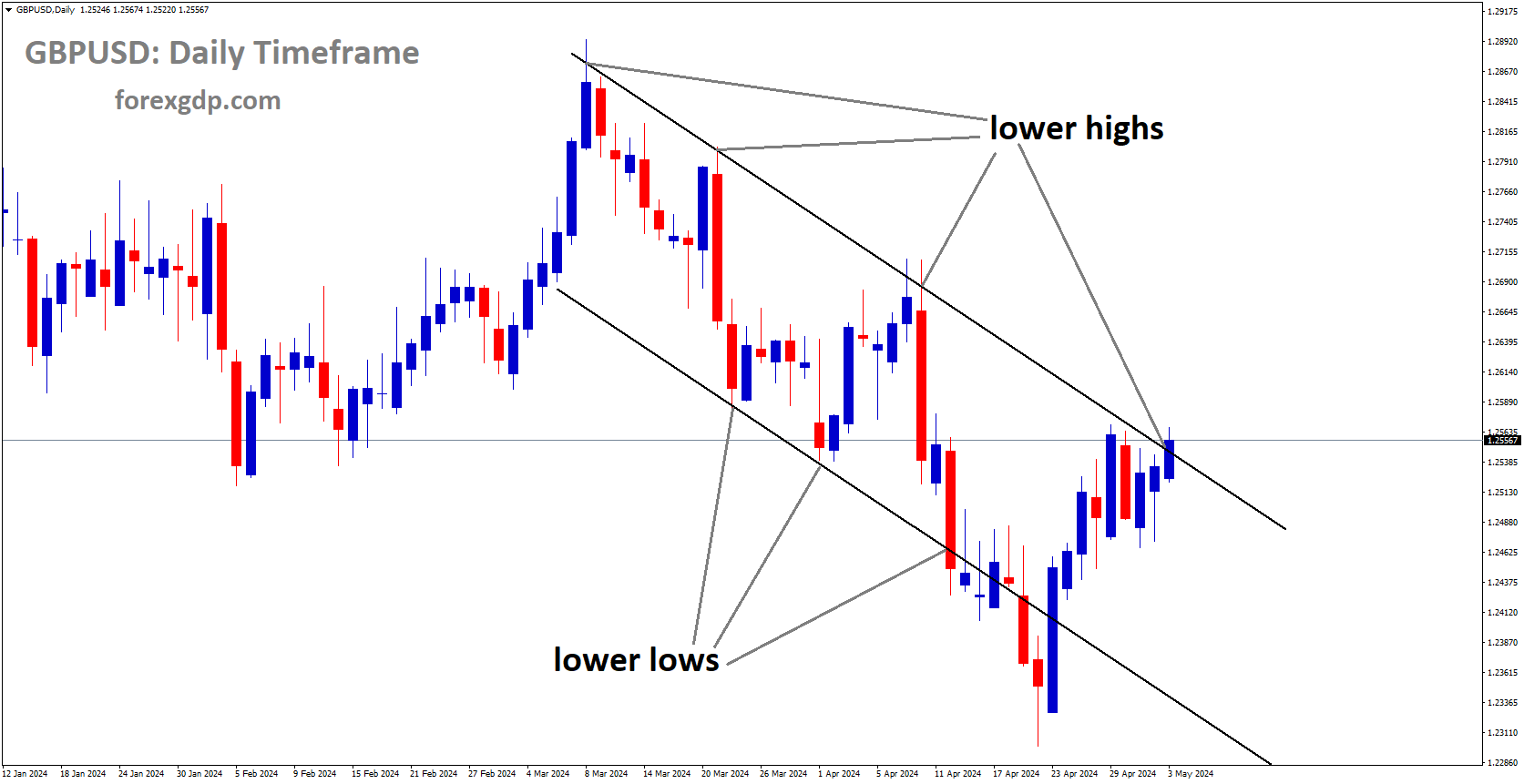GBPUSD is moving in Descending channel and market has reached lower high area of the channel
GBPUSD – Pound Sterling’s Resilience Amidst Policy Speculation and Economic Data
Amidst a backdrop of evolving market dynamics, the Pound Sterling showcases resilience, bolstered by a combination of factors including an optimistic market sentiment and the weakening stance of the US Dollar. This interplay of forces sets the stage for the Pound’s continued ascent.
At the forefront of investor attention is the Bank of England (BoE), widely anticipated to initiate a course of interest rate reduction commencing from its upcoming September meeting. This speculation, swirling within financial circles, underscores the importance of central bank policies in shaping currency movements. As investors recalibrate their expectations, the anticipation of a potential shift in interest rates adds an element of intrigue to the market landscape.
However, amidst the speculation surrounding interest rate adjustments, concerns linger regarding the robust wage growth observed in the United Kingdom. This wage growth, a key driver of inflationary pressures, introduces a note of caution into the market narrative. The implications of wage dynamics on inflation trends and subsequently on monetary policy decisions underscore the intricate web of economic variables influencing currency markets.
BoE Governor Andrew Bailey’s remarks regarding inflation further contribute to the nuanced market outlook. Bailey’s expressed confidence in the eventual return of headline inflation to the BoE’s target rate of 2% offers a glimmer of assurance amid the prevailing uncertainty. The upcoming monetary policy decision on May 9 looms large, with market participants eagerly awaiting clues regarding the central bank’s stance on interest rates and its broader economic outlook.

Against this backdrop, the Pound Sterling’s upward trajectory against the US Dollar gains momentum, fueled by market optimism. The GBP/USD pairing strengthens as expectations align with the possibility of coordinated monetary policy adjustments between the BoE and the US Federal Reserve. The market’s reaction to these expectations reflects the intricate interplay of monetary policy divergence and convergence across major economies.
However, amidst the prevailing optimism, uncertainties loom on the horizon. The impending release of key economic data, including the United States Nonfarm Payrolls (NFP) and the ISM Services Purchasing Managers Index (PMI) reports for April, adds a layer of complexity to the market narrative. These data releases have the potential to sway investor sentiment and reshape market expectations, underscoring the importance of data-driven decision-making in financial markets.
Market projections for the US NFP report, estimating a decline in job additions compared to previous readings, hint at potential shifts in labor market dynamics. Similarly, attention is focused on the Average Hourly Earnings data, offering insights into inflationary pressures and their implications for monetary policy. These data points serve as crucial barometers of economic health, guiding investor sentiment and shaping market expectations.
Amidst these developments, the broader market mood remains upbeat, buoyed by positive signals from the S&P 500 and a general appetite for risk among investors. However, the trajectory of the US Dollar adds a layer of complexity to the market dynamics. The Dollar’s depreciation, reflected in the US Dollar Index (DXY) nearing a three-week low, is driven by a combination of factors including lackluster Q1 Nonfarm Productivity data and the Federal Reserve’s dovish stance on interest rates.
Pound Sterling’s resilience against the US Dollar reflects the intricate interplay of economic variables and market sentiment. As investors navigate through a landscape of evolving expectations and uncertainties, the dynamics of central bank policies, economic data releases, and broader market trends shape the currency markets’ trajectory, underscoring the complexity of modern financial markets.
XAUUSD – Slide Amidst Market Optimism A Look Ahead at Key Economic Data
Gold prices are sliding as market optimism grows, dampening the appeal of safe-haven assets. This shift in sentiment follows the Federal Reserve’s recent meeting, where a slightly dovish tone left investors feeling upbeat. Despite this positive outlook, traders remain cautious ahead of the US Nonfarm Payroll labor report.
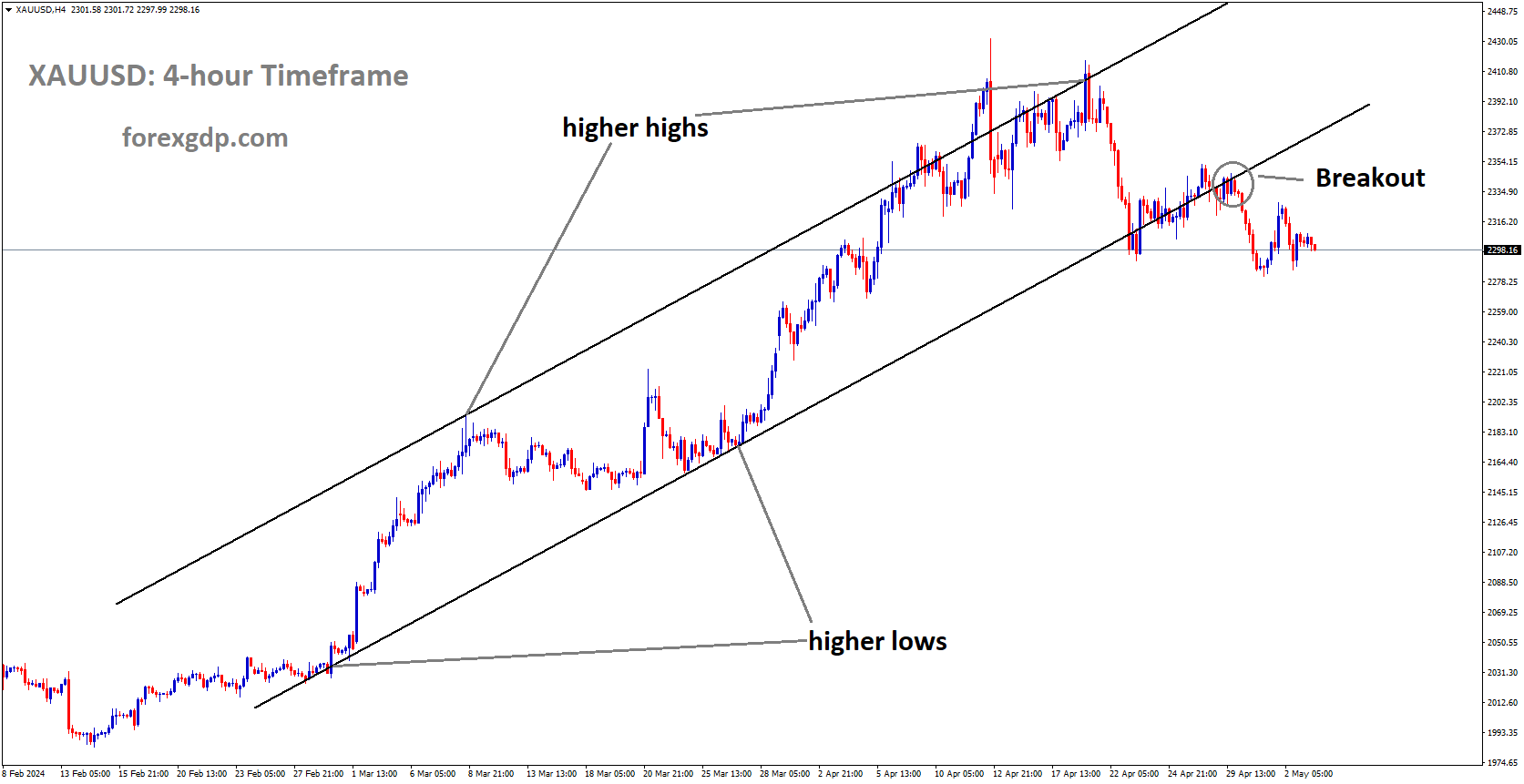
XAUUSD has broken Ascending channel in downside
On Friday, the price of gold, reflected by XAU/USD, is inching downwards, hovering just above the $2,300 threshold. This downward trend reflects reduced demand for gold amidst a generally positive market atmosphere. The fluctuating nature of gold prices underscores the apprehension among traders, who are closely monitoring developments in the market.
The prevailing optimism is evident as Asian stock markets mirror the upward trend seen on Wall Street, alleviating concerns sparked by fears of potential interest rate hikes by the Federal Reserve. The Fed’s recent decision to slow down quantitative tightening, coupled with Chairman Jerome Powell’s indications that interest rates are unlikely to rise soon, have bolstered confidence among investors.

While the initial reaction to the Fed’s stance provided a boost to gold prices, the subsequent improvement in global market sentiment has tempered demand for gold as a safe-haven asset. All eyes are now on the release of key economic data, particularly the US Nonfarm Payrolls (NFP) report for April, which is expected to provide valuable insights into the health of the US economy.
Analysts are anticipating a decline in nonfarm job additions compared to the previous month, with expectations set at 243,000 new jobs. Additionally, Average Hourly Earnings are forecasted to rise by 0.3% month-on-month and 4.0% year-on-year. Any significant deviations from these forecasts could trigger volatility in gold prices, depending on their implications for inflation and interest rate expectations.
The silver market found itself encountering a series of challenges as traders approached with a sense of caution in anticipation of the impending release of the US Nonfarm Payrolls report on Friday. This report held significant weight as a potential softer outcome could influence the Federal Reserve to adopt a more restrained approach regarding its trajectory on interest rates.
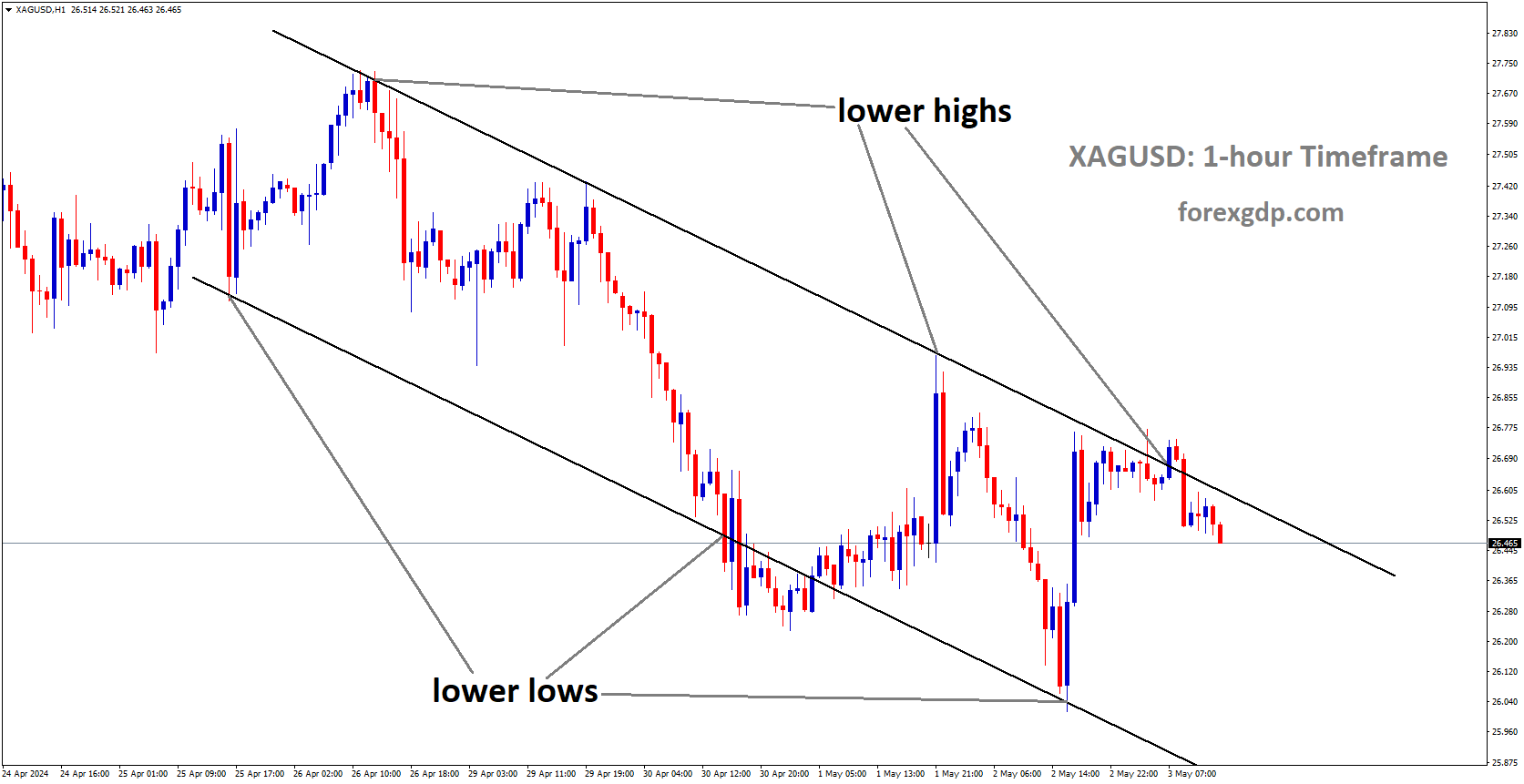
XAGUSD is moving in Descending channel and market has fallen from the lower high area of the channel
Concurrently, Egypt’s proactive involvement in reinvigorating peace talks between Israel and Hamas added a layer of complexity to the silver market dynamics. Historically, silver has been perceived as a safe-haven asset, sought after during times of geopolitical uncertainty. However, with prospects of a potential resolution to the longstanding conflict in the Middle East, the appeal of silver as a haven asset was undermined, thereby impacting its price.
The silver market’s trajectory was further influenced by its performance during Friday’s European session, where it snapped its two-day winning streak, trading around the $26.50 mark per troy ounce. Traders exercised caution ahead of the release of the Nonfarm Payrolls (NFP) data from the United States, with expectations pinned on a reading of 243K for April, compared to the previous figure of 303K. This potential decline in job creation figures could offer support for a less hawkish stance by the Federal Reserve on its interest rate policy, which in turn could influence silver prices.

Moreover, Thursday’s US Initial Jobless Claims report showed stability, with no significant change from the previous week’s figures, remaining at 208K, the lowest level in two months. This unexpected stability could provide the Federal Reserve with the flexibility to postpone interest rate adjustments, potentially dampening the demand for non-yielding assets like silver.
The Federal Reserve’s decision to maintain interest rates unchanged at 5.25-5.50% on Wednesday suggested a continued inclination towards future rate cuts. This stance, combined with Fed Chair Jerome Powell’s less hawkish remarks during the Federal Open Market Committee (FOMC) conference, contributed to a prevailing selling bias in the US dollar. This, in turn, acted as a supportive factor for silver prices.
Intricate interplay of factors such as the US Nonfarm Payrolls report, geopolitical developments in the Middle East, and the Federal Reserve’s monetary policy stance all contributed to the nuanced dynamics shaping the silver market during this period.
EURUSD – US Nonfarm Payrolls Impact and Forecasts
US Nonfarm Payrolls are projected to increase by 243,000 in April, a decline from the previous month’s gain of 303,000. The Bureau of Labor Statistics will release the United States Employment report at 12:30 GMT. With the Federal Reserve signaling its intent to maintain higher rates for an extended period, market focus shifts to employment data.
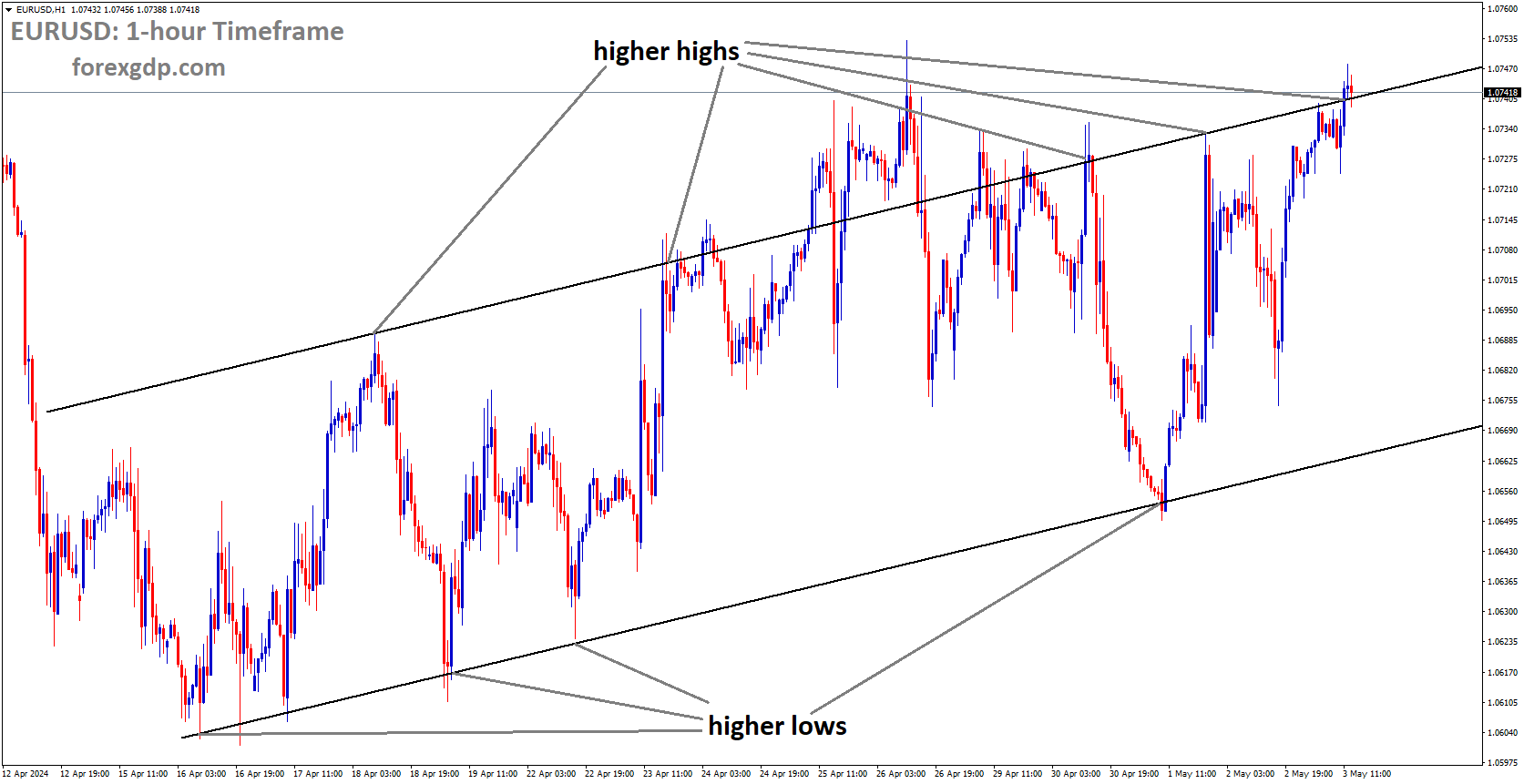
EURUSD is moving in Ascending channel and market has reached higher high area of the channel
After the recent Federal Reserve policy announcements, all eyes are on the forthcoming high-impact Nonfarm Payrolls (NFP) data, scheduled for release at 12:30 GMT on Friday. Published by the Bureau of Labor Statistics (BLS), this data will play a crucial role in shaping market sentiment and influencing the timing and extent of potential Fed interest rate adjustments this year.
The upcoming Nonfarm Payrolls report is anticipated to reveal a 243,000 job increase in the US economy for the previous month, a notable decrease from the robust job creation observed in March. Concurrently, the Unemployment Rate is expected to hold steady at 3.8%. Additionally, Average Hourly Earnings, a significant measure of wage inflation, are forecasted to grow by 4.0% year-on-year through April, slightly lower than the previous month’s figure of 4.1%.
Investors will closely scrutinize the headline NFP figure alongside wage inflation data to assess potential shifts in Fed rate cut timing, particularly in light of Chair Jerome Powell’s recent comments, which left room for speculation.

Following the May policy meeting, the Federal Reserve opted to maintain the Fed Funds Rate within the 5.25% to 5.5% range, while also reducing the Treasury runoff from its balance sheet. Powell highlighted a shift in the Fed’s stance towards prolonging higher borrowing costs, emphasizing the need for confidence in inflation trends.
Recent economic indicators, including core PCE inflation and the US Employment Cost Index, have supported the Fed’s stance on maintaining higher rates. However, Powell dismissed the possibility of an immediate rate hike, signaling a dovish tilt towards potential rate cuts later this year, with September emerging as a likely timeframe.
In related news, the ADP reported a modest decrease in private sector job additions for April compared to March, exceeding analysts’ expectations. However, US job openings experienced a decline according to BLS data, diverging from market forecasts.
As anticipation builds for the April jobs report, analysts anticipate a slight decrease in job additions compared to March, alongside steady unemployment rates. Attention will also be on wage growth trends, which influence core services CPI inflation.
USDJPY – Japanese Yen Strengthens Factors and Market Outlook
The Japanese Yen is on a notable upward trajectory, marking its third consecutive day of gains on Friday, and reaching a three-week high as it enters the European trading session. This recent surge in the value of the Yen is attributed to speculation surrounding potential government intervention in the currency markets. There are rumors circulating that Japan’s financial authorities have intervened for the second time this week in an effort to strengthen the domestic currency. This intervention, if confirmed, serves to lend support to the Japanese Yen, adding to its upward momentum.
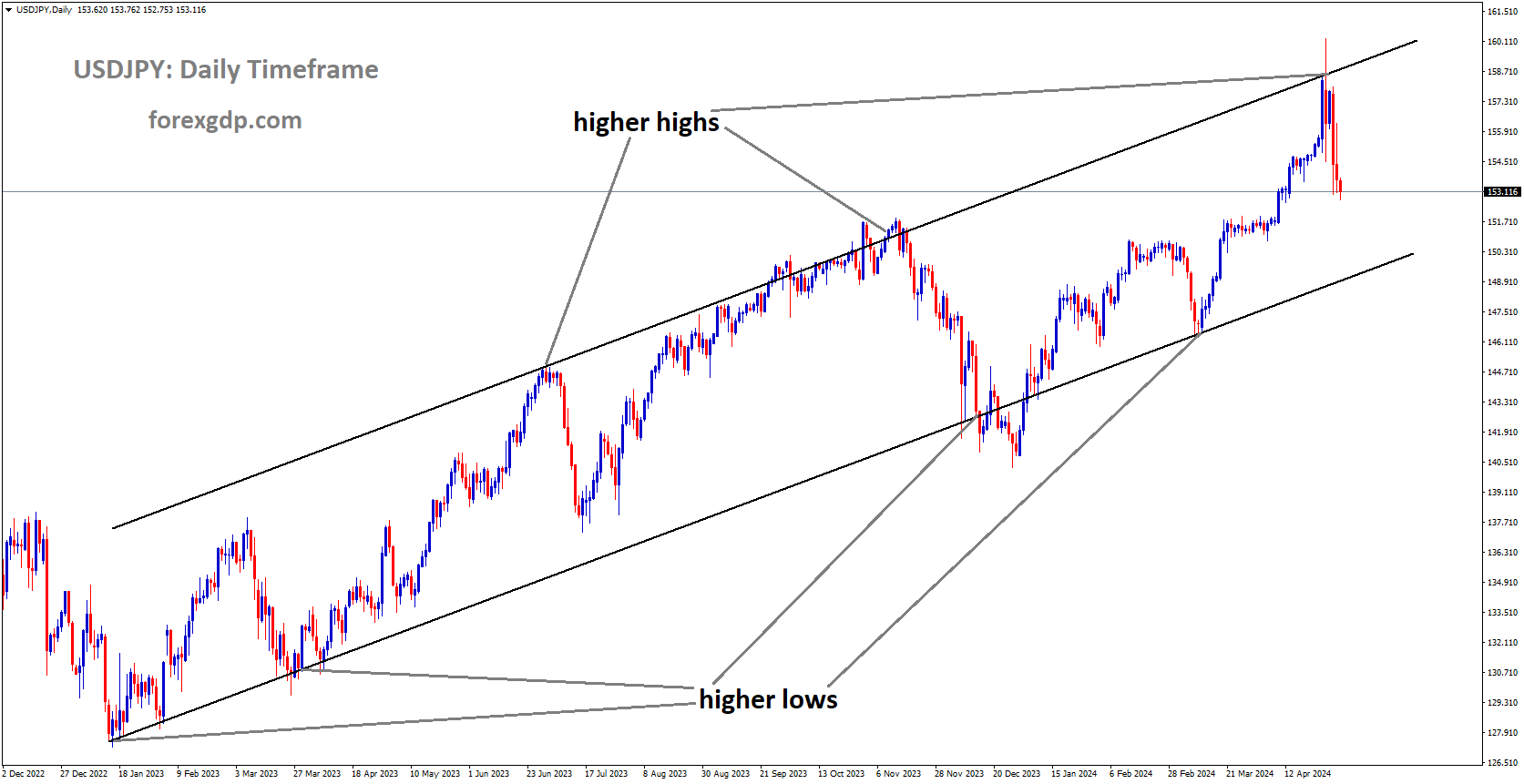
USDJPY is moving in Ascending channel and market has fallen from the higher high area of the channel
Furthermore, the post-FOMC selling pressure on the US Dollar (USD) has contributed to the strengthening of the Japanese Yen against the greenback, exerting additional downward pressure on the USD/JPY pair. This dynamic reflects broader market sentiment and expectations following the latest Federal Open Market Committee (FOMC) meeting.
Investors are closely monitoring the interest rate differentials between Japan and the United States, anticipating that the gap will persist for the foreseeable future. This interest rate disparity, coupled with a generally positive tone in equity markets, acts as a headwind for the safe-haven appeal of the Japanese Yen. Despite the Yen’s strength, the downside for the USD/JPY pair is somewhat limited by these factors.
Market participants are exercising caution and refraining from making aggressive directional bets, opting instead to await the release of the highly anticipated US Nonfarm Payrolls (NFP) report later in the day. The NFP report, a key economic indicator, is expected to provide fresh insights into the health of the US labor market and could influence market sentiment and trading activity in the USD/JPY pair.
Recent data from the Bank of Japan indicates significant intervention efforts, with officials potentially spending a substantial amount to support the Yen. However, Japanese authorities have refrained from directly confirming these interventions, opting instead to disclose details at a later date.

Meanwhile, the Federal Reserve’s stance on monetary policy has implications for the US Dollar and, by extension, the USD/JPY pair. Despite persistent inflationary pressures, the Fed has signaled a reluctance to pursue further interest rate hikes in the near term. This dovish stance from the Fed contrasts with the Bank of Japan’s commitment to maintaining accommodative financial conditions, potentially influencing market dynamics.
Attention is now turning to a press conference to be held by Japan’s finance minister and the Governor of the Bank of Japan on the sidelines of the Asian Development Bank (ADB) meeting. Market participants will be keenly watching for any remarks or announcements that could provide further insight into Japan’s monetary policy and intervention efforts.
Japanese Yen’s recent strength against the US Dollar is driven by a combination of factors, including speculation of government intervention, post-FOMC USD selling, and interest rate differentials between Japan and the United States. However, market sentiment remains cautious ahead of the release of the US NFP report, which could provide further direction for the USD/JPY pair.
USDCAD – Declines on Fed Decision, Jobless Claims Steady
Last week, the US Initial Jobless Claims remained unchanged at 208,000, indicating stability in the labor market amid ongoing economic conditions. Concurrently, Bank of Canada (BoC) Governor Tiff Macklem articulated the challenges associated with diverging Canadian monetary policy from that of the United States (US), stressing the existence of limits to such divergence.
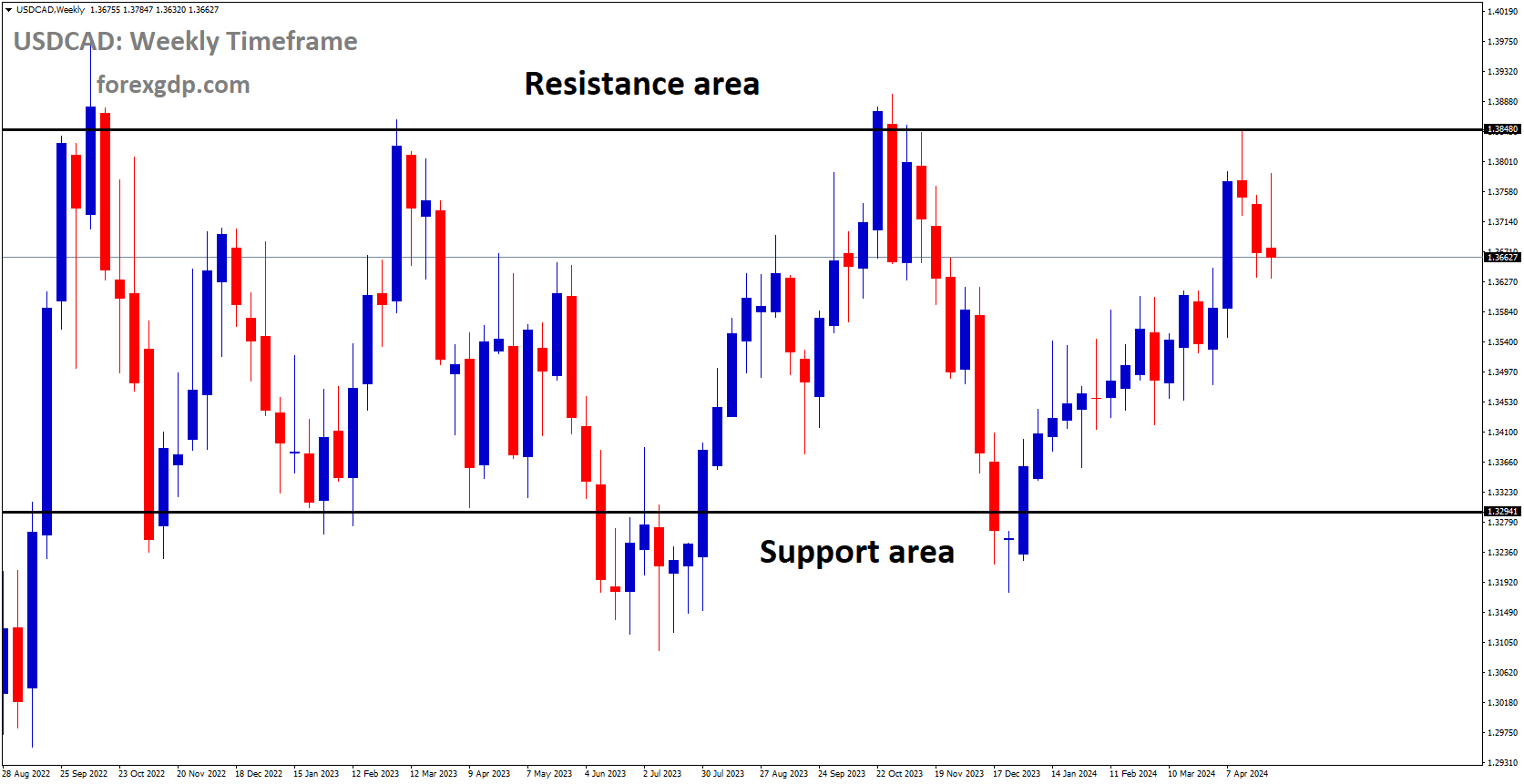
USDCAD is moving in box pattern and market has fallen from the resistance area of the pattern
During Friday’s early Asian trading session, the USD/CAD pair extended its downward movement, largely influenced by a weakening US Dollar (USD). This depreciation of the USD follows the Federal Reserve’s decision to maintain interest rates unchanged, coupled with Fed Chair Jerome Powell’s less hawkish stance compared to market expectations. Investors now await the release of US April employment data, which is anticipated to offer crucial insights into the state of the economy.
The Federal Reserve’s monetary policy announcement on Wednesday emphasized a cautious approach towards rate adjustments, indicating a prolonged period before attaining confidence in inflation’s progression towards the 2% target. Powell reiterated the unlikelihood of an imminent rate hike, emphasizing the necessity for additional data to inform such decisions. Additionally, the Fed announced a deceleration in its balance sheet runoff (QT), signaling a shift in its monetary policy stance.

In contrast, Thursday’s data from the US Department of Labor (DOL) revealed consistent Initial Jobless Claims at 208,000, surpassing market expectations of 212,000. This stability in jobless claims suggests ongoing resilience in the labor market, despite prevailing economic uncertainties.
Turning to the Canadian Dollar (CAD), Governor Macklem’s remarks underscored the intricacies of aligning Canadian monetary policy with that of the US. While financial markets anticipate potential interest rate cuts by the BoC in response to easing inflationary pressures in Canada, the divergence between US and Canadian interest rates poses challenges for the CAD. This divergence may exert downward pressure on the CAD in the foreseeable future, thereby limiting the downside potential for the USD/CAD pair.
USDCHF – Dips on Dollar Weakness, Swiss Inflation
In the early hours of Friday’s European trading session, the USD/CHF pair continues its downward trend, marking its third consecutive day in negative territory. The pair has retreated from a recent high, a level not seen in seven months. This decline is primarily attributed to the broader weakness in the US Dollar (USD) against major currencies. Market participants are eagerly awaiting the release of the highly anticipated US Nonfarm Payrolls (NFP) report for April, which is expected to provide crucial insights into the health of the US labor market. Analysts forecast that the report will reveal 243,000 new job additions in the US economy.
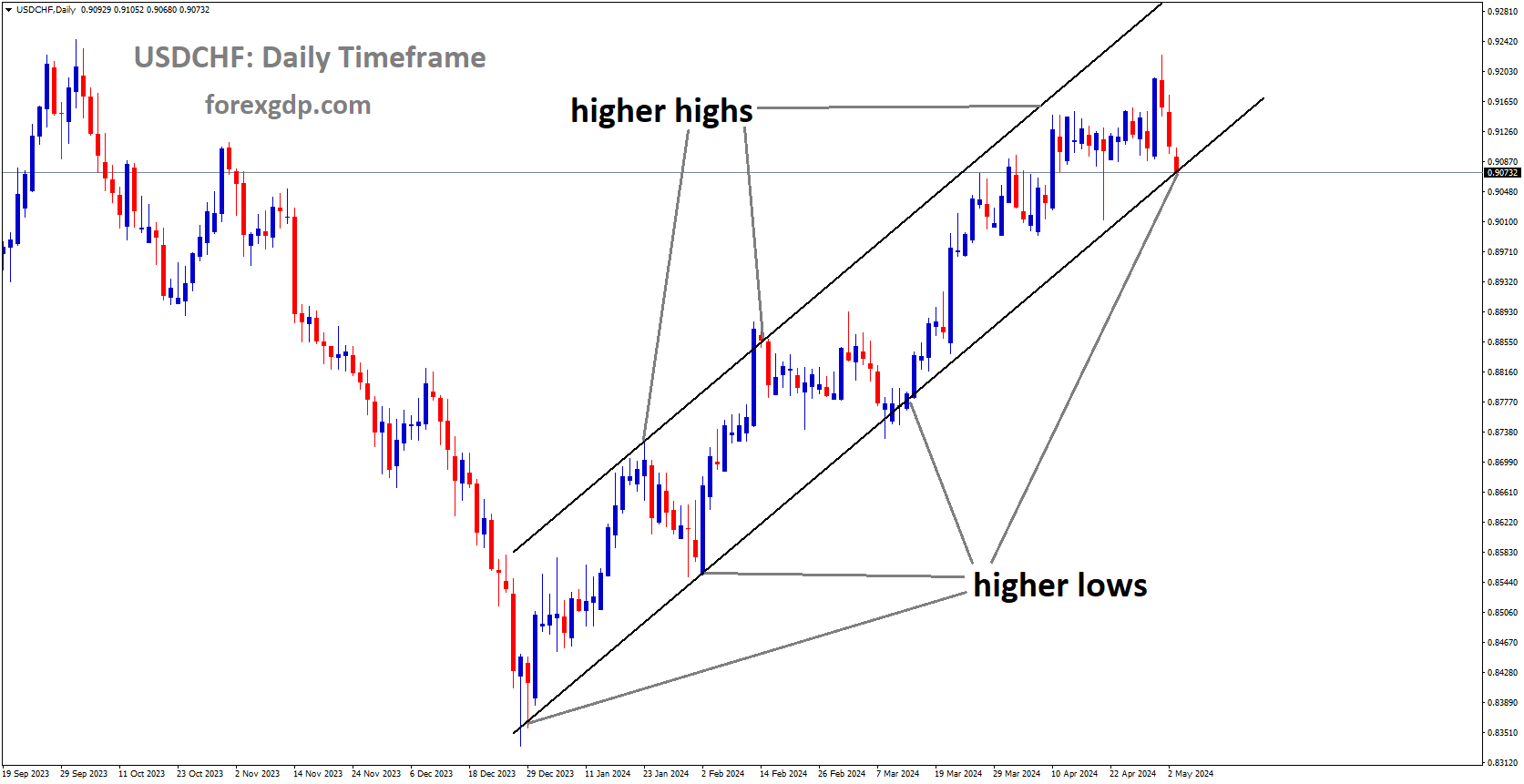
USDCHF is moving in Ascending channel and market has reached higher low area of the channel
During its meeting on Wednesday, the US Federal Reserve (Fed) opted to keep its monetary policy unchanged. Fed Chair Jerome Powell, speaking at the subsequent press conference, acknowledged that recent progress on inflation has been slower than anticipated. Powell emphasized the need for a longer period to gain confidence that inflation is moving towards the Fed’s target of 2%. The prevailing narrative of expectations for higher interest rates in the US may provide some support to the USD in the short term, thereby limiting the downside potential for the USD/CHF pair. Additionally, the Fed announced a slowdown in its balance sheet runoff (QT), indicating a shift in its policy stance.

In Switzerland, the Federal Statistics Office reported on Thursday that annual inflation exceeded expectations for April. The Swiss Consumer Price Index (CPI) inflation climbed to 1.4% year-on-year, surpassing the market consensus. This unexpected acceleration in inflation prompted a strengthening of the Swiss Franc (CHF) against its major counterparts, including the USD. Consequently, the stronger CHF created headwinds for the USD/CHF pair’s downward movement.
Last week, Swiss National Bank (SNB) Chairman Thomas Jordan stated that the central bank had effectively managed to control inflation. According to Jordan, the SNB expects inflation to remain within its target range over the next few years. Such remarks further bolster confidence in the Swiss economy and support the CHF’s position in the forex market.
AUDUSD – AUD Rises on RBA Outlook & USD Weakness
The Australian Dollar (AUD) maintains its upward momentum, bolstered by a hawkish outlook regarding the Reserve Bank of Australia (RBA) and its potential to sustain higher interest rates. The AUD’s resilience extends for the third consecutive session on Friday, lending support to the AUD/USD pair.
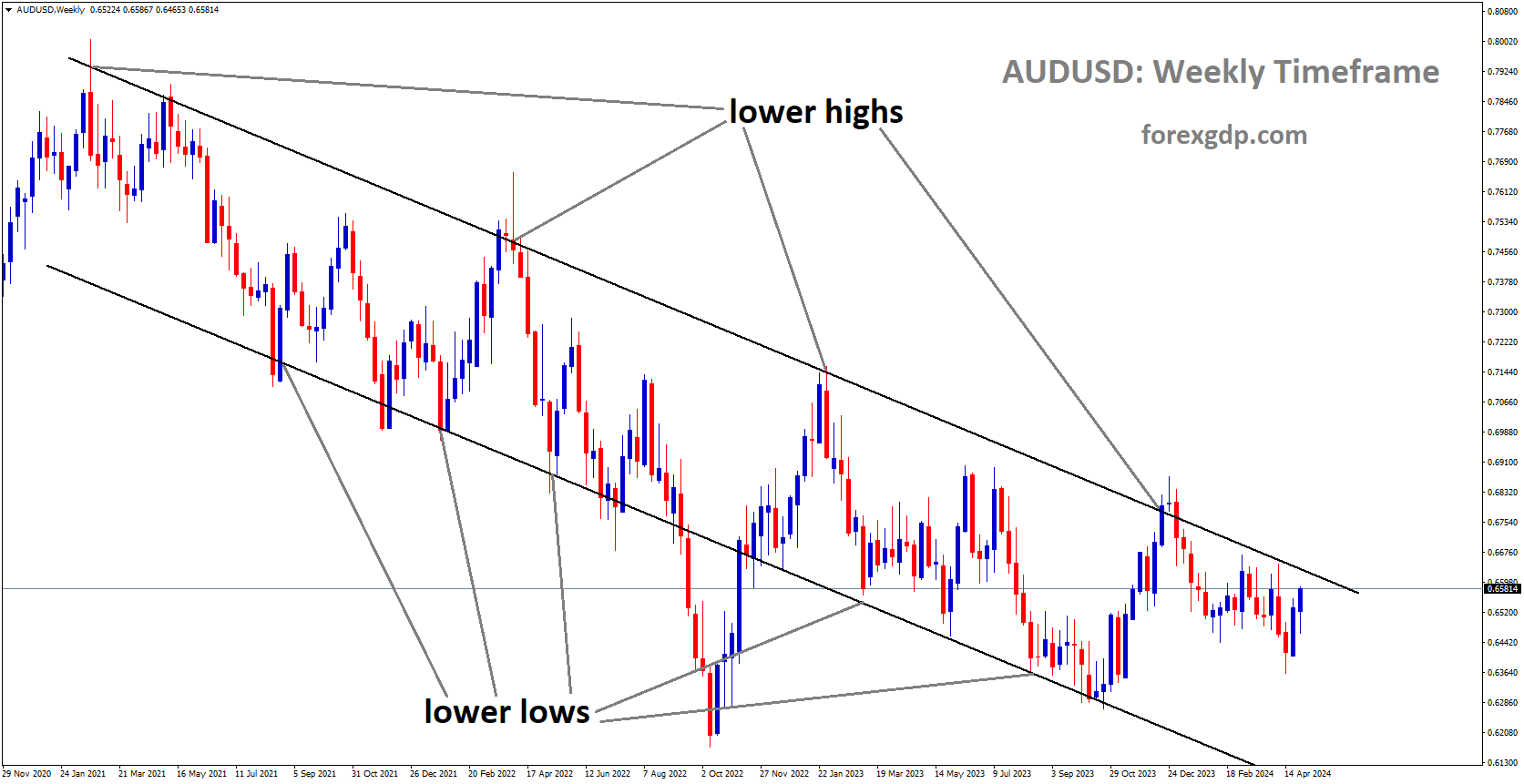
AUDUSD is moving in Descending channel and market has reached lower high area of the channel
Market expectations lean towards the RBA maintaining its current interest rate of 4.35% until at least the end of September, based on a Reuters poll of economists. This stance aligns with projections of only one interest rate cut anticipated throughout the year, particularly following the release of stronger-than-expected domestic inflation data last week. Such indicators have fueled speculations that the RBA might delay any further cuts to interest rates.
Concurrently, the US Dollar Index (DXY) remains subdued, influenced by dovish remarks from US Federal Reserve Chairman Jerome Powell following the decision to uphold the interest rate range of 5.25%-5.50%. Powell’s dismissal of the likelihood of another rate hike contributes to the USD’s depreciation.
Investor focus now shifts towards the release of crucial US employment data for April, including Average Hourly Earnings, Nonfarm Payrolls, and ISM Services PMI. These reports are anticipated to offer deeper insights into the overall health of the US economy.

In Australia, the Judo Bank Australia Composite Purchasing Managers Index (PMI) shows a marginal decline to 53.0 in April, indicating slightly slower growth in the private sector output, primarily driven by a decrease in manufacturing output. However, gains in the ASX 200 Index for the second consecutive session are buoyed by positive movements on Wall Street and reassurances from the Federal Reserve regarding interest rates.
Notably, US Initial Jobless Claims remain stable at 208K, maintaining the lowest level in two months, potentially affording the Federal Reserve flexibility in postponing rate cuts. Conversely, US Nonfarm Productivity rose by 0.3% in the first quarter, falling short of expectations, signaling a sluggish pace of productivity growth.
Recent Australian economic data, including Trade Balance and Building Permits, have shown mixed results, with the surplus in trade balance and an increase in building permits falling slightly below market expectations.
Federal Reserve Chairman Powell’s remarks underscore the challenges in addressing stagnant inflation, suggesting a cautious approach towards rate cuts. Market indicators, such as the CME FedWatch Tool, reflect a slight decrease in the probability of rate maintenance during the June meeting, coupled with an increased likelihood of a rate cut.
In summary, the AUD’s ascent is underpinned by optimism surrounding the RBA’s stance on interest rates, while market dynamics and economic data releases continue to shape investor sentiment and currency movements.
AUDJPY – RBA Sentiment, Japanese Interventions, and Tax Breaks
AUD/JPY pair stumbled as the Japanese Yen (JPY) surged, prompted by whispers of potential market interventions orchestrated by Japanese authorities. Masato Kanda, Japan’s vice finance minister for international affairs, maintained a tight-lipped stance regarding any such interventions. Simultaneously, the Australian Composite PMI slipped in April, hinting at a deceleration in the pace of growth within the private sector Down Under.
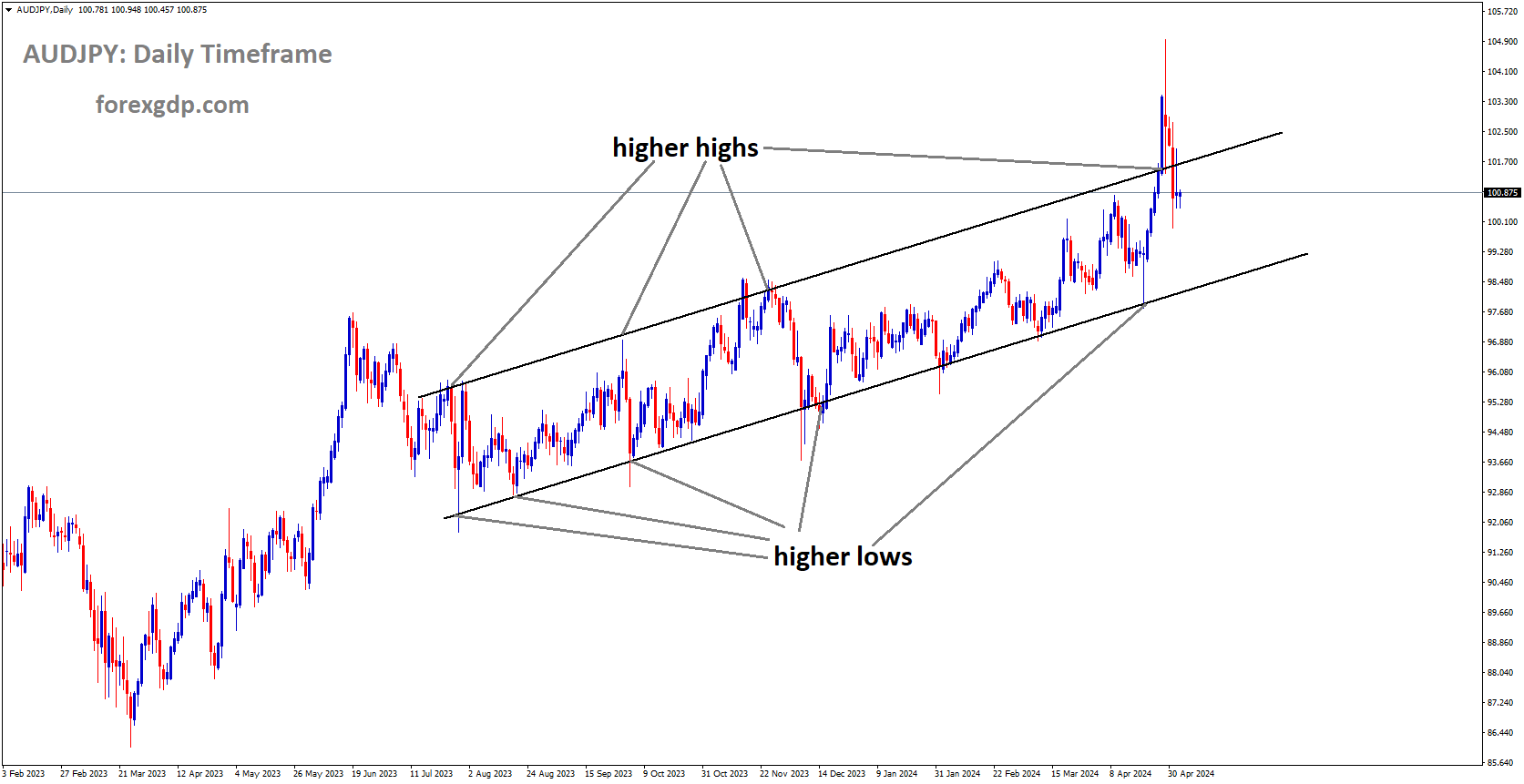
AUDJPY is moving in Ascending channel and market has fallen from the higher high area of the channel
In the wake of reports hinting at Japanese government interference, AUD/JPY experienced a downturn as the JPY gathered strength, marking the second such occurrence within the week. The reticence of Masato Kanda on this matter coincided with the closure of Japanese banks for Greenery Day.
Insights gleaned from the Bank of Japan (BoJ) minutes from the March meeting suggested a stable outlook on monetary policy, with expectations of minimal repercussions from short-term rate adjustments. The Australian Dollar (AUD) might discover support amidst the prevailing hawkish sentiment enveloping the Reserve Bank of Australia (RBA), widely expected to maintain its key policy rate in the imminent meeting.
Detailing the economic landscape, the Australian private sector exhibited a marginal deceleration, evidenced by the Judo Bank Australia Composite PMI slipping to 53.0 in April. Meanwhile, the ASX 200 Index notched consecutive gains, mirroring the upbeat sentiment on Wall Street, bolstered by the US Federal Reserve’s reassurances regarding interest rates.

Australia’s economic indicators delivered mixed results, with both the Trade Balance and Building Permits figures falling short of market expectations in April and March respectively. Additionally, the Consumer Confidence Index retreated to a three-month nadir in April, indicative of subdued sentiment among households.
Adding a layer of intrigue, reports surfaced suggesting Japan’s contemplation of tax breaks to incentivize the repatriation of corporate profits into the Yen. This prospective measure, potentially included in the mid-year policy blueprint, underscores Japan’s strategic maneuvers amidst the evolving global economic landscape.
NZDUSD – Sustained Rise Amid USD Weakness
NZD/USD pair continues its upward trajectory in Friday’s early Asian trading session, maintaining its position signaling its third consecutive day of gains. This sustained momentum is predominantly attributed to the prevailing weakness in the US Dollar (USD), which remains under selling pressure across currency markets.
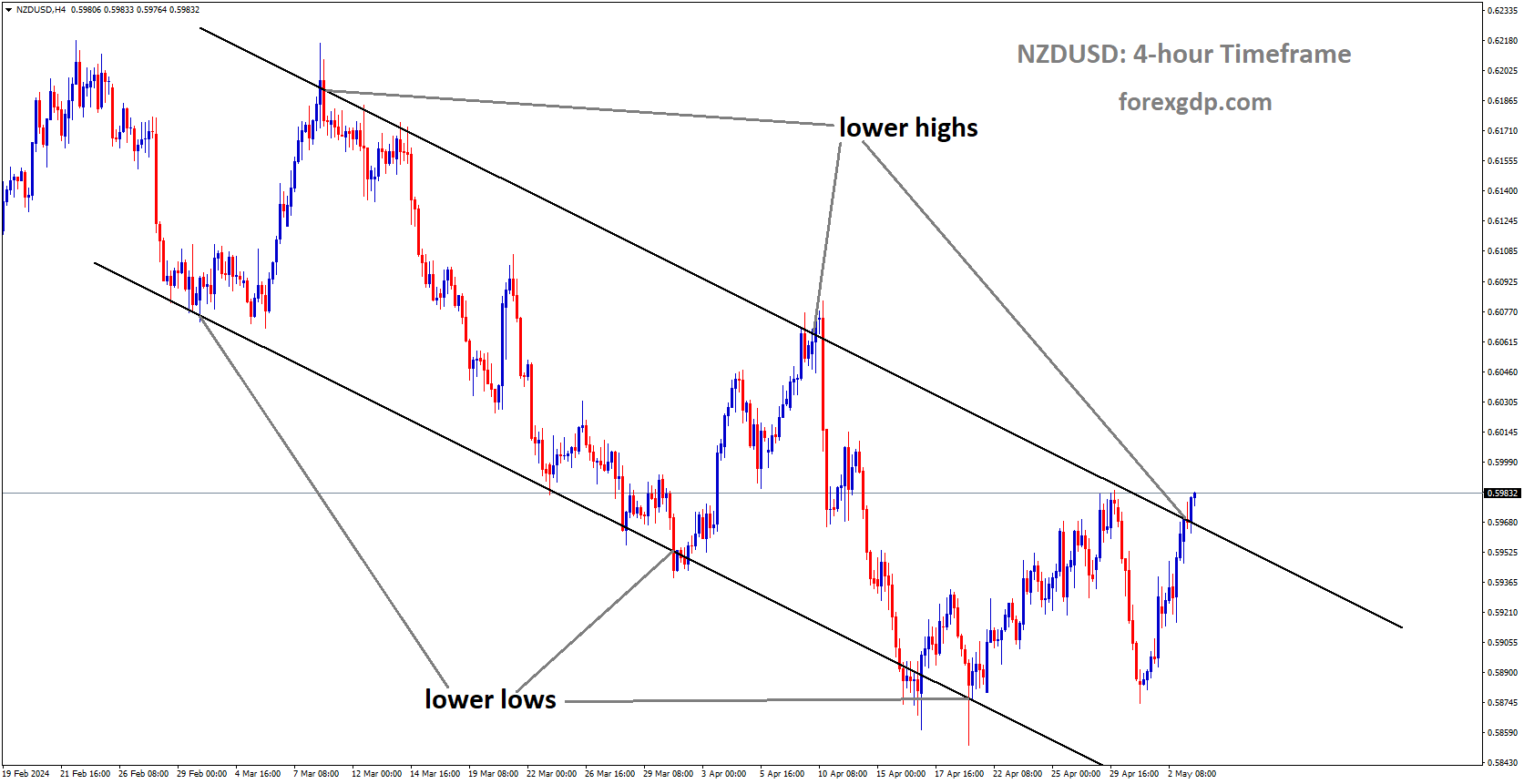
NZDUSD is moving in Descending channel and market has reached lower high area of the channel
A key contributor to the positive sentiment surrounding the NZD/USD pair is the release of data from the US Department of Labor (DOL), indicating that initial jobless claims for the week ending April 27 remained steady at 208,000. This figure outperforms market expectations, which had anticipated a slightly higher reading of 212,000. The better-than-expected jobless claims data bolsters confidence in the US economy and lends support to the NZD/USD pair’s upward movement.
In contrast, the US Federal Reserve (Fed) adopts a cautious stance regarding monetary policy, emphasizing the necessity of sustained moderation in inflation levels before contemplating adjustments to interest rates. Fed Chair Jerome Powell’s recent statements suggest that market participants anticipate only one rate cut, potentially occurring in November, as indicated by futures prices tracked by CME FedWatch. This cautious approach from the Fed, while exerting a minor influence, does little to dampen the NZD/USD pair’s positive performance.

Turning attention to the Reserve Bank of New Zealand (RBNZ), the central bank acknowledges the gradual decline in global inflation and the corresponding adjustments in financial markets, which anticipate lower policy rates in the upcoming year. However, the RBNZ also highlights the potential risk of renewed inflationary pressures, which could extend the duration of restrictive global interest rates. Despite this cautious outlook, the RBNZ signals its intent to defer any potential monetary easing until 2025, buoyed by stronger-than-expected inflation pressures recorded in the first quarter of the year. This steadfast stance from the RBNZ serves to bolster the New Zealand Dollar (NZD) and reinforces the NZD/USD pair’s positive trajectory.
NZD/USD pair’s upward movement in Friday’s early trading session is sustained by a combination of factors, including the weakness of the US Dollar, encouraging jobless claims data from the US, and the supportive stance of the RBNZ regarding monetary policy. These factors collectively shape investor sentiment and contribute to the pair’s overall market direction.
Don’t trade all the time, trade forex only at the confirmed trade setups
Get more confirmed trade signals at premium or supreme – Click here to get more signals , 2200%, 800% growth in Real Live USD trading account of our users – click here to see , or If you want to get FREE Trial signals, You can Join FREE Signals Now!

